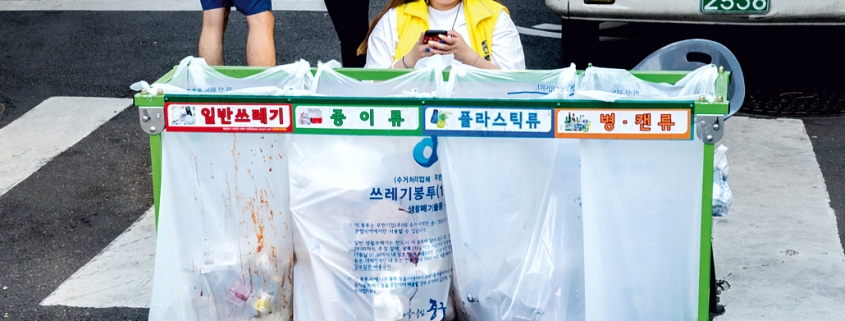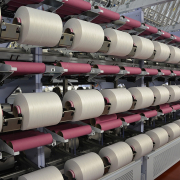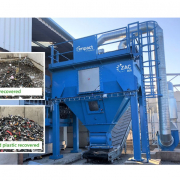South Korea: The Aim Is a Resource-Circulating Society
By the time China banned the import of several types of waste due to the “National Sword Policy”, South Korea had to deal with a waste problem, in particular regarding used plastics and recovered paper.
In April 2018, nearly 50 recycling companies in Seoul and the surrounding region had stopped collecting plastic waste, and the garbage began piling up at apartment complexes, Haeryun Kang described the situation on koreaexpose.com. “The reasons given for the stoppage were varied,” he stated and referred to the ban, rising labor costs, falling prices of recyclable materials and declining profit. According to the information, the Korean government intervened quickly “to ensure that collection would resume”.
At that time, the main problem was the huge quantity of plastic waste. The Republic of Korea is the largest consumer of plastic per capita in the world, a national survey revealed in 2016, according to koreaexpose.com. A report from the Korean government informed that the volume of plastic waste was 6.9 million tons in 2015. 60 percent of this quantity was recycled within South Korea; 230,000 tons were exported. The goal of the Korean government is the reduction of plastic waste in the country by half up to 2030. The problem with recovered paper was not the volume, but the price. In South Korea, a considerable part of the used paper is collected by elderly men and women; many of them are homeless. As reported by koreaexpose.com, the price collapse of recovered paper due to the Chinese ban had serious implication for those collectors who depend on the money. As a result, the Korean government forbade companies to lower the unit cost of used paper they buy, the information said; now manufacturers were importing more recovered paper from abroad.
South Korea’s waste generation
According to the National Waste Statistics Survey, conducted by the Korean Ministry of Environment every five years, the amount of residential waste generated per person has decreased from 1.3 kilograms per day in 1994. In 2012, the per capita amount of residential waste generation was 0.95 kilogram per day. “The reduction of the amount of residential waste generation can be attributable to the implementation of the volume-based waste fee system and the separate discharge policy for recycling materials and food waste,” the ministry gave account on its homepage. All in all, more than 51 million people live in South Korea and generated 48,990 tons per day (2011: 48,934 tons). On the other hand, the amount of industrial waste is on the rise. In particular, the amount of construction waste generated increased significantly between the late 1990s and the late 2000s on the back of the booming construction industry, the ministry reported, but the trend is slowing due to the downturn of the industry since 2011. In 2012, the daily quantity came to 186,629 tons per day (2011: 186,417).
In addition, the amounts of general industrial waste – which increased to a volume of 146,390 tons/day in 2012 from 137,961 tons in 2011 – and designated (or hazardous) waste (2012: 12,501 tons/day, 2011: 10,021 tons/day) are consistently on the rise due to the surge in industrial production, the ministry wrote.
High recycling rates
Officially, the Republic of Korea recycles more than 85 percent of all waste, Korean media referred to a 2017 government study. On the other hand, the media noted that illegally dumped waste could be found in rural areas of the country. Despite this criticism, the Korean waste management system is rather efficient.
According to Korea’s Environmental Review 2015, ECOREA, 10.3 percent of the country’s waste (including residential and business waste) was buried, 6.3 percent incinerated, 82.4 percent recycled and 1.0 percent discharged into the sea. As of 2012, 97.3 percent of construction waste and 76.5 percent of business waste were recycled, 14.9 percent of them were landfilled, 6.5 percent incinerated and 2.1 percent discharged into the sea, while 54.4 percent of designated waste (the term refers to the industrial waste specifically enumerated by Presidential Decree as harmful substances) was recycled, 16.4 percent incinerated, 23.0 percent landfilled and 6.2 percent treated by other measures (storage). “Although the percentages of waste treated by incineration or recycled have been increasing annually, the rates of waste treated by landfill and ocean dumping have been decreasing,” the information said. The reduction of waste discharged into the sea is the result of the ban regarding the ocean dumping of sewage sludge, food waste leachates and livestock wastewater in 2012-2013; the treatment methods for these types of waste were being changed to incineration or recycling.
The Korean way
The success of the national waste management is associated with rapid economic growth, urbanization and industrialization of the 1970s and ’80s. “A suitable legal system was not in place during that time, and due to the capacity limit of the Nanjido Landfill Site, new waste treatment facilities were required,” the Korean Ministry of Strategy and Finance and KRIHS (Korea Research Institute for Human Settlements) reported in the 2016 publication “Waste Resources Management and Utilization Policies of Korea”. In 1986, the “Waste Control Act” came into effect, followed by the implementation of a set of policies and systems. Before this law, waste management policies were managed under a bifurcated system involving domestic waste and industrial waste under the “Refuse Cleaning Act” and the “Environment Conservation Act”.
In the 1990s, a transition from the reactive waste management scheme to a preventive one was carried out. “As the ‘Recycling Promotion Act’ became effective in 1992, policies and systems designed to promote recycling, such as deterring the generation of packaging materials, regulations on single-use products, the waste deposit system and waste fee system, cultivation of recycling industries, etc., were implemented,” the ministry and KRIHS informed. “In 1995, the ‘Volume-Rate Disposal System’, which is a system of deterring waste generation that applies the principle of pay-as-you-throw, was implemented.” This system, evaluated as the representative market-incentive regulation in Korea, would represent a shift from the former system, in which a fixed fee was charged regardless of the volume of waste disposal, to a system where a proportional fee is applied to the volume discharged. As reported, it provides an incentive to reduce the volume of discharge and to increase recycling. Furthermore, in 1995 the “Promotion of Installation of Waste Facilities and Assistance, Etc. to Adjacent Areas Act” was issued to prevent in advance the NIMBY (not in my backyard) phenomenon due to the installation of incineration facilities and to resolve and mediate social conflicts through means such as assistance projects to residents of impacted adjacent areas.
In the 2000s, a framework for a resource-recirculation society was pursued. According to this master plan, waste was not simply treated but recycled as a resource. Currently, Korea pursues a “Zero Waste” policy, which seeks to utilize wastes as a source of resources, in addition to minimizing waste generation, the authors of the publication underlined.
In 2002, the “Second National Master Plan for Waste Management” (2002-2011) was established, and in 2007 a revised plan was set up. In 2003, the “Deposit System” was changed to an “Extended Producer Responsibility” system. The legislative framework was extended by the “Construction Waste Recycling Promotion Act”, the prohibition on direct landfill burial of food waste (2005) and the “Act on Resource Circulation of Electrical and Electronic Equipment and Vehicles” (2007).
From the late 2000s onwards, reducing greenhouse gases has been required due to rapid increases in the prices of resources and energy, along with global warming. Therefore, the government especially emphasized the need for resource and energy recovery from waste. In September 2011, the Korean Ministry of Environment established the “First Framework Plan (2011-2015) for Resource Circulation” to form a foundation for upcycling waste resources and thereby promote green growth aiming for a resource circulating (zero-waste) society. Besides, the “Measure for Promotion of Transition to a Resource Circulation Society” (2013) promotes the collection and transportation of recyclable resources through a free-of-charge collection of large-sized domestic electronic equipment waste, consolidation of the sorting system, increased installation of facilities for the energy utilization of waste resources “and other such foundations of a recycling society”. The creation of a market for recycled products and support for the industries thereof was also announced.
The “Framework Act on Resource Circulation” (FARC) was decreed in 2016 to form a basis for the implementation of these policies; the Korean government enforced it since 2018. “As a resource-poor and heavy energy-using society, Korea faces serious environmental, economic and social threats,” the Ministry of Environment wrote in the “Korea Environmental Policy Bulletin”. The country intends to transform the mass production-oriented and mass waste-producing economic structure into a much more sustainable and efficient resource-circulating one at a fundamental level. The provisions of the framework “can be divided into three categories, each of which is establishing a basis for resource circulation, promoting resource circulation and supporting recycling industries,” the ministry underlined. It “introduces new waste management related programs such as ‘Recyclable Resource Recognition Program (RRRP)’, ‘Resource Circulation Performance Management Program (RCPMP)’, ‘Waste Disposal Fees’ and so on.” With the FARC the government expects to have economic, environmental and social benefits by preventing environmental pollution, but is also aware of the fact that the country is required “to make further efforts to shift the policy paradigm on waste control”.
Opportunities for investment from abroad
In July this year, the country’s Ministry of Trade, Industry and Energy (MOTIE) and KOTRA (Korea Trade-Investment Promotion Agency) held the first “Invest Korea Forum in 2019”. Foreign investment in Korea reached 26.9 billion US-Dollar last year, attaining an all-time high, according to the information.
The Forum intends to support the achievement of more than 20 billion US-Dollar foreign investment for five consecutive years “by sharing the information on foreign investment promotion environments around the world, improving strategies and expertise of investment promotion agencies and companies,” one could read on Ü www.investkorea.org. For that purpose, it offers various programs.
According to the homepage, Korea has a well-established system for foreign direct investment (FDI) and provides various incentives to induce capital spending. Since adopting the “Foreign Investment Promotion Act” (FIPA) in 1998, the Korean government has significantly deregulated and opened up the country’s capital expenditure market to foreign investors. Over time, the country’s foreign investment policies have evolved toward qualitative growth, particularly for high-value-added industries that can enhance the global competitiveness and potential of the Korean economy and create more jobs.
Tenders regarding public procurement in Korea can be found at www.pps.go.kr/eng/. The Asian Development Bank informs about procurement plans in Asia (www.adb.org/site/business-opportunities/main).
(GR 32019, Page 19, Photo: VittoriaChe | Dreamstime.com)








